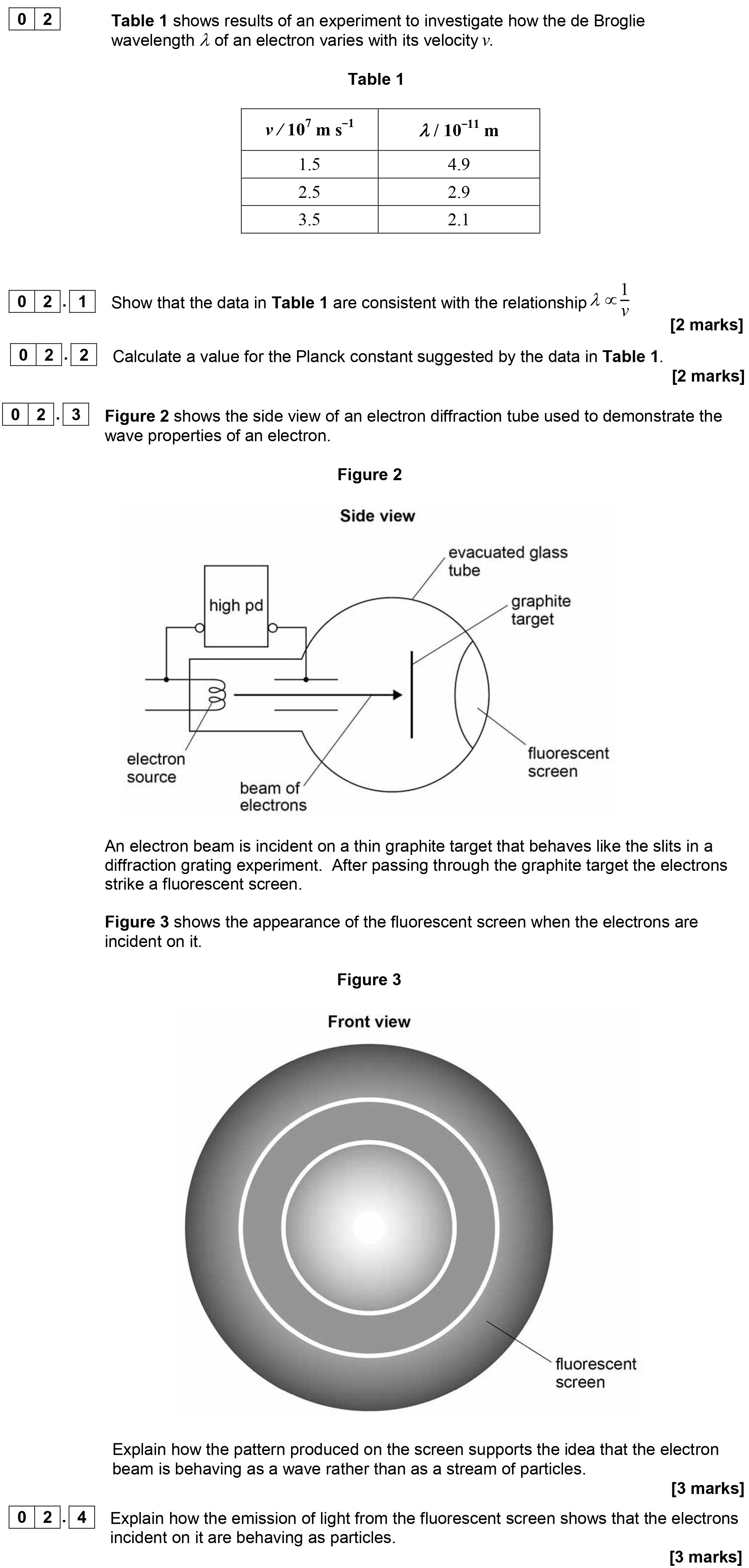Photo AI
Table 1 shows results of an experiment to investigate how the de Broglie wavelength $\\lambda$ of an electron varies with its velocity $v$ - AQA - A-Level Physics - Question 2 - 2018 - Paper 1
Question 2

Table 1 shows results of an experiment to investigate how the de Broglie wavelength $\\lambda$ of an electron varies with its velocity $v$. | $v / 10^7 \, \text{m... show full transcript
Worked Solution & Example Answer:Table 1 shows results of an experiment to investigate how the de Broglie wavelength $\\lambda$ of an electron varies with its velocity $v$ - AQA - A-Level Physics - Question 2 - 2018 - Paper 1
Step 1
Show that the data in Table 1 are consistent with the relationship $\lambda \propto \frac{1}{v}$
Answer
To demonstrate this relationship, we can analyze the data in Table 1. According to the relationship ( \lambda \propto \frac{1}{v} ), if we plot ( \lambda ) against ( \frac{1}{v} ), we should see a linear relationship.
Calculating ( \frac{1}{v} ) for each value in the table:
- For , ( \frac{1}{v} = \frac{1}{1.5 \times 10^7} = 6.67 \times 10^{-8} \text{ s m}^{-1}$ and ( \lambda = 4.9 \times 10^{-11} \text{ m})
- For , ( \frac{1}{v} = 4.00 \times 10^{-8} \text{ s m}^{-1}$ and ( \lambda = 2.9 \times 10^{-11} \text{ m})
- For , ( \frac{1}{v} = 2.86 \times 10^{-8} \text{ s m}^{-1}$ and ( \lambda = 2.1 \times 10^{-11} \text{ m})
Upon plotting these pairs, we will find that ( \frac{1}{v} ) is indeed proportional to ( \lambda ). Therefore, the data supports the initial relationship.
Step 2
Calculate a value for the Planck constant suggested by the data in Table 1
Answer
To find the Planck constant, we utilize the de Broglie relation: [ \lambda = \frac{h}{mv} ] Where:
- ( h ) is the Planck constant
- ( m ) is the mass of the electron (approximately ( 9.11 \times 10^{-31} \text{ kg} ))
- ( v ) is the velocity from Table 1
Using the first set of data:\n- For ( v = 1.5 \times 10^7 \text{ m s}^{-1} ) and ( \lambda = 4.9 \times 10^{-11} \text{ m} ), we rearrange the equation: [ h = \lambda mv ] [ h = (4.9 \times 10^{-11})(9.11 \times 10^{-31})(1.5 \times 10^7) ] Calculating this value gives us an approximate value of the Planck constant. Repeating this for other data points will yield consistent values, thereby confirming our calculation.
Step 3
Explain how the pattern produced on the screen supports the idea that the electron beam is behaving as a wave rather than as a stream of particles
Answer
The electron beam produces an interference pattern on the fluorescent screen, which is a hallmark of wave behavior. When waves from the slits (i.e., the graphite target) overlap, they create regions of constructive and destructive interference.
The alternating bright and dark bands observed on the screen indicate that the electrons are behaving like waves: where waves coincide in phase, bright spots form (constructive interference), and where they are out of phase, dark spots appear (destructive interference). This pattern cannot be explained by particle-like behavior, as particles would simply create two distinct spots corresponding to the slits.
Step 4
Explain how the emission of light from the fluorescent screen shows that the electrons incident on it are behaving as particles
Answer
While the pattern produced on the screen indicates wave behavior, the emission of light upon electron impact supports particle-like behavior. Each electron striking the fluorescent screen transfers energy to the atoms in the screen, causing them to emit light.
This discrete interaction implies that the electrons possess specific locations and energies, much like individual particles, which supports the notion that the electrons can also behave as particles. The sharp emission of light can only occur when individual electrons collide with the screen, further highlighting their particle-like nature.
